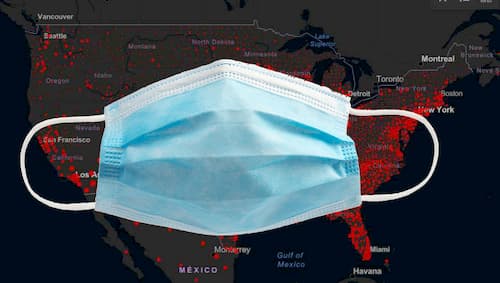WHITE HOUSE — Facing growing pressure from impatient state governors, the Biden administration acknowledged for the first time that it is developing plans to guide the country away from the pandemic’s emergency phase toward a more relaxed national response, including ending the federal recommendation for wearing masks in most indoor settings.
“We are internally discussing, of course, what it looks like to be in the phase of the fight against the COVID pandemic where it is not disrupting everyone’s daily lives,” White House press secretary Jen Psaki told reporters Wednesday. “We recognize people are tired of the pandemic. They’re tired of wearing masks.”
The U.S. Centers for Disease Control and Prevention (CDC) currently recommends “universal indoor masking,” including in businesses and schools, “regardless of vaccination status and regardless of what states require.”
While some states follow the CDC guidance, pandemic health protocols have always varied by state with different requirements for masks, vaccines and testing.
Now more states are relaxing coronavirus health protocols, including New York, Massachusetts, New Jersey, California, Connecticut, Delaware, Illinois, Rhode Island and Washington. The rule changes, implemented by both Republican and Democratic governors, include lifting indoor mask requirements in certain settings, such as schools and businesses, as well as rescinding vaccine mandates.
Psaki insisted that while administration officials understand the need to be flexible, they are following the advice of medical experts who rely on scientific evidence.
“That doesn’t move at the speed of politics; it moves at the speed of data,” she said.
The CDC said it is working on new guidance.
“We are working on following the trends for the moment,” CDC director Dr. Rochelle Walensky said Wednesday.
Democrats joining Republicans
In the first two years of the pandemic, Democrats were more in favor of strict public health restrictions while Republicans largely rejected them.
But now, with vaccination rates higher than 70% in some states and polls showing public pandemic fatigue, Democratic governors and state officials are also relaxing measures to avoid a backlash.
“Public health is made up of two words. The health part we focus on a lot of science and the data, but we need to understand the public part as well,” Dr. Anand Parekh, chief medical adviser at the Bipartisan Policy Center, said to VOA.
Over the past week, an average of more than 227,000 new coronavirus cases has been reported each day in the United States, a decrease of 63% from the national pandemic peak of more than 806,000 cases in mid-January, according to data tracked by The New York Times. Hospitalizations are also declining significantly across the country.
“For the next few weeks, we should see a decrease in epidemic activity. All of the indicators seem to go down,” Alessandro Vespignani said to VOA. Vespignani is the director of the Network Science Institute at Northeastern University and leads a team of infectious-disease modelers who have been developing COVID-19 projections since the pandemic began.
Governors are seeing this trend, recognizing that their citizens are weary, and in the absence of CDC guidance, taking steps to relax restrictions.
“The CDC and the administration are trying to play catch-up to that reality,” Parekh said, underscoring that the federal response must focus not only on the moment but what it would look like a month from now.
“We see time and time again, federal agencies being late. We saw that with respect to omicron and testing just a couple of months ago,” he said.
Many public health experts are still advising caution.
The downward trend needs to be sustained over a period of several weeks and reduced even further before the nation can transition from pandemic to endemic response, said Dr. William Schaffner, professor of medicine in the Infectious Diseases Division at the Vanderbilt University School of Medicine.
“Endemic is where we kind of have a truce with the virus,” Schaffner said, and the strain on the health care system will be “substantially diminished.”
“At the moment I stand with the CDC,” Schaffner told VOA. “Let’s keep wearing our masks. Let’s allow the cases to really come down. Let’s do this for another month or two, to be absolutely sure, not only that we’re heading down but that we’ll stay down.”[content id=”79272″]
Vespignani added, “We could see bumps in the road due to omicron-2, a mutated version of the omicron variant that has begun to circulate in some places.”
He said the easing of mitigations should be done in a way that makes sure we keep facilitating the quick decreasing trends in infections.
“It is more and more important to increase the number of vaccinated and boosted individuals,” he said. “This is the wall that we want to be as high as possible to protect us in case of any future wave of the pandemic.”
A recent Monmouth University poll found that 70% of Americans surveyed agree with the sentiment that “it’s time we accept that COVID is here to stay and we just need to get on with our lives.”
“Americans’ worries about COVID haven’t gone away. It seems more to be a realization that we are not going to get this virus under control in a way that we thought was possible just last year,” said Patrick Murray, director of the Monmouth University Polling Institute.
Just 52% supported face mask and distancing guidelines in their home state, down from a peak of 63% last September during the delta variant surge, the Monmouth poll found.
Countries changing restrictions
Some other countries are making similar moves. Spain and Italy – two European countries with high vaccination rates, declining infection numbers and lower hospitalization figures, are loosening measures this week to coexist with the coronavirus.
England, France, Ireland, the Netherlands, the Czech Republic and several Nordic countries, including Denmark and Sweden, have also taken steps to end or relax their restrictions.
China, meanwhile, is maintaining its most stringent protocols. During the Winter Olympics, Beijing is keeping its “zero-COVID” policy of testing, mass lockdowns and strict social restrictions as authorities worry about the ability of the Chinese health care system to cope and adapt to new strains.
Besides China, India, Canada, Germany, Angola and Indonesia are some of the countries with the strictest government COVID policies, according to the Government Stringency Index put together by researchers at the Blavatnik School of Government at the University of Oxford.
Nine metrics are used to calculate this index – school closures, workplace closures, cancellation of public events, restrictions on public gatherings, closures of public transport, stay-at-home requirements, public information campaigns, restrictions on internal movements and international travel controls.
While some European leaders have said that COVID-19 should be treated as an endemic, like influenza, the World Health Organization says that’s premature.
“We are now starting to see a very worrying increase in deaths, in most regions of the world,” WHO Director-General Tedros Adhanom Ghebreyesus said in remarks to media earlier this month.
“It’s premature for any country either to surrender, or to declare victory,” he said.
“Since Omicron was first identified just 10 weeks ago, almost 90 million cases have been reported to WHO – more than were reported in the whole of 2020. We are now starting to see a very worrying increase in deaths, in most regions of the world”-@DrTedros #COVID19
— World Health Organization (WHO) (@WHO) February 1, 2022
American public health experts said the debate in the U.S. to lift restrictions must take into account the steps being taken to prevent new variants.
“Only 10% of people in low-income countries around the world have been vaccinated,” Parekh said. “Until we can vaccinate the rest of the world, the threat of variants and the threat to the United States will still be there.”
Vanderbilt’s Schaffner said helping countries vaccinate their population is necessary not only for humanitarian reasons, but also self-interest.
“Those variants can come from abroad and be here in no time,” he said.
The U.S. remains the largest donor of vaccines. At least 414 million doses of vaccines have been shipped, about 34% of the 1.3 billion doses pledged by the administration.
[content id=”52927″][content id=”79272″]







